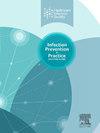Efficacy of heparin–vancomycin–amikacin combination lock in preventing catheter-related infections in haemodialysis patients: a double-blind randomized clinical trial
IF 1.9
Q3 INFECTIOUS DISEASES
引用次数: 0
Abstract
Background
Haemodialysis patients with tunnelled central venous catheters (CVCs) are at high risk for catheter-related infections (CRIs), which can lead to serious complications, prolonged hospitalizations, and increased healthcare costs. The use of antibiotic lock solutions may help prevent these infections. This study evaluates the efficacy of a heparin–vancomycin–amikacin combination lock solution in preventing CRIs compared with heparin alone in haemodialysis patients.
Methods
This single-centre, double-blind randomized clinical trial involved 60 haemodialysis patients with tunnelled CVCs. Patients were randomly assigned to receive either a heparin 5000 units/mL lock (Group A) or a combination of heparin 5000 units/mL, vancomycin 500 mg/mL, and amikacin 500 mg/mL lock (Group B). The primary outcome was the incidence of CRIs, diagnosed using CDC criteria, over a 6-month follow-up period.
Findings
Group B demonstrated a significantly lower incidence of CRIs compared to Group A (P=0.001). Additionally, the mean number of CRI episodes per patient and the CRI rate per 1000 catheter days were significantly lower in Group B (P=0.028 and 0.042, respectively). The rate of catheter removal due to infection was also significantly reduced in Group B (P=0.029). No significant differences in infection timing were observed, although Group B showed later infection onset. No adverse drug reactions were reported.
Conclusions
The heparin–vancomycin–amikacin combination lock solution was more effective in preventing CRIs than heparin alone in haemodialysis patients. Further studies with larger sample sizes and longer follow-up are needed to confirm its long-term benefits and assess potential risks, including antibiotic resistance.
肝素-万古霉素-阿米卡星联锁预防血液透析患者导管相关性感染的疗效:一项双盲随机临床试验
背景:使用隧道中心静脉导管(CVCs)的血液透析患者发生导管相关感染(CRIs)的风险很高,这可能导致严重的并发症、住院时间延长和医疗费用增加。使用抗生素锁溶液可能有助于预防这些感染。本研究比较了肝素-万古霉素-阿米卡星联合锁液在血液透析患者中预防cri的效果,并与单用肝素进行了比较。方法本研究为单中心、双盲随机临床试验,纳入60例血液透析患者。患者被随机分配接受肝素5000单位/mL锁(a组)或肝素5000单位/mL、万古霉素500 mg/mL和阿米卡星500 mg/mL锁(B组)的联合治疗。主要结局是在6个月的随访期间,使用CDC标准诊断的cri发生率。结果:B组cri发生率明显低于a组(P=0.001)。此外,B组患者平均CRI发作次数和每1000导管天CRI率均显著低于B组(P分别=0.028和0.042)。B组因感染拔管率也显著降低(P=0.029)。B组感染发病时间较晚,感染时间无明显差异。未见药物不良反应报告。结论肝素-万古霉素-阿米卡星联合锁液预防血液透析患者cri的效果优于单用肝素。需要进行更大样本量和更长时间随访的进一步研究,以确认其长期益处并评估潜在风险,包括抗生素耐药性。
本文章由计算机程序翻译,如有差异,请以英文原文为准。
求助全文
约1分钟内获得全文
求助全文
来源期刊

Infection Prevention in Practice
Medicine-Public Health, Environmental and Occupational Health
CiteScore
4.80
自引率
0.00%
发文量
58
审稿时长
61 days
 求助内容:
求助内容: 应助结果提醒方式:
应助结果提醒方式:


